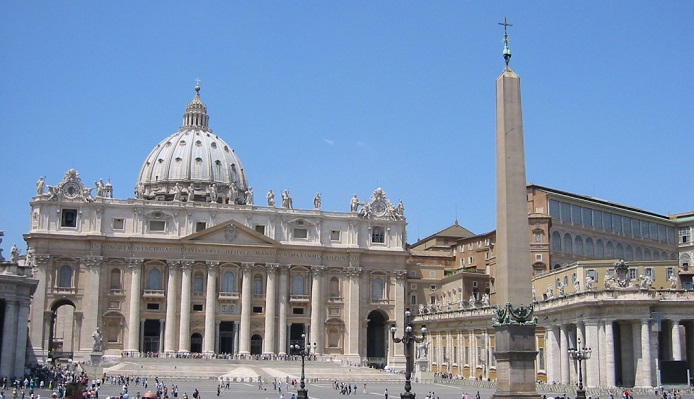
Your virtual Italy vacation continues as Thor and I visit St. Peter’s Basilica at the Vatican in Rome.
NOTE: Since travel is still on hold with the pandemic continuing, I’ve started a new blog series offering a virtual vacation and time-travel to my first big trip with Thor in 2008. Italy! Starting with highlight photos posted here on Saturday, Jan. 30, I’ll continue every week. Join us in Rome, Florence, Cinque Terre, Venice, and Milan. Buon viaggio!
St. Peter’s Basilica is the largest Christian church in the world and the object of pilgrimage for believers from around the world. It’s also an amazing creation of Renaissance and Baroque architects and artists, so of course Thor and I couldn’t miss visiting. The entrances are protected by Swiss mercenary guards in colorful uniforms possibly designed by Michelangelo, though I will give him the benefit of the doubt.
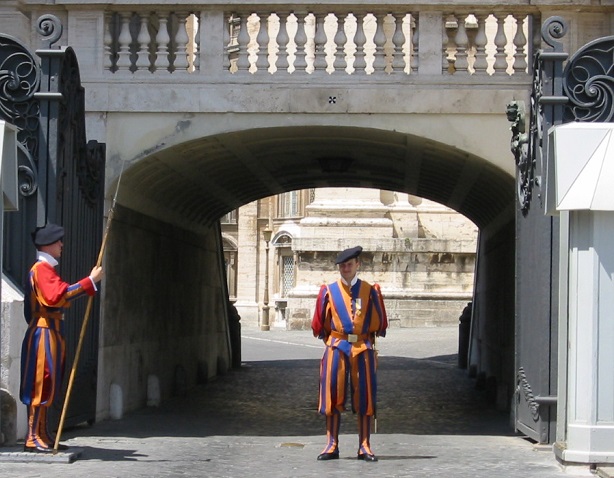
Below is a closer look at the basilica, with its iconic dome and massive portico. The expansive St. Peter’s square fronting it is actually an oval, originally Nero’s Circus chariot racecourse. The obelisk in the center (top photo) is 90 feet tall, solid granite weighing about 300 tons. It was erected in Egypt over 2000 years ago, and then Emperor Caligula brought it to Rome. If the stone could talk! It has overseen the slaughter of Christians during the Circus “half time entertainments,” and then the torture of Protestants by the Inquisition in the building just outside the square. Dian Lorenzo Bernini, the Baroque architect, designed the new incarnation of the square with enclosing columns — 284 Doric columns, 56 feet high. The oval “square” has about same dimensions as the ancient Coliseum.
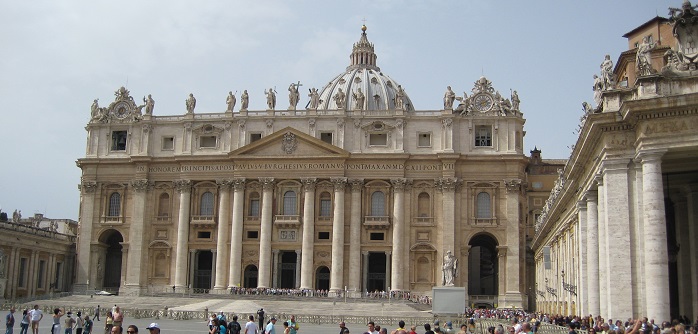
The first Christian church here was built by Constantine in 326 A.D., when he legalized Christianity. Christ’s disciple Peter was crucified on the site, and since he was named “the rock” upon which the new religion would stand, his burial site here became the foundation for this important shrine that has remained a worship center ever since. By 1500, during the Renaissance, the original church was deteriorating and unsafe, so the new basilica was built around it before the old church was demolished. Michelangelo was one of the architects, his design a Greek cross of equal legs. (Bernini and others would later expand the design, lengthening it.) Michelangelo was 71 when asked to do undertake the project, and he designed the dome inspired by the ancient Roman Pantheon. The massive front portico over the entrance doors was added later. The entire project took 150 years to build, and another 200 to decorate.
Here we enter beneath the portico (the Narthex). This porch is bigger than most churches, with some white columns from the original church.
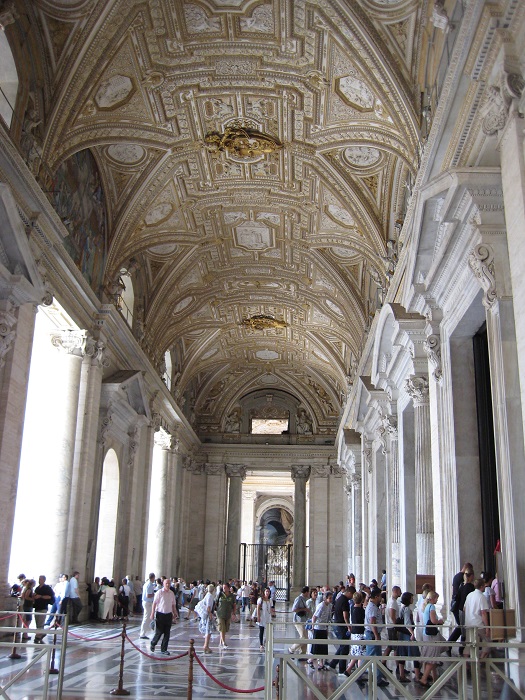
The soaring spaces inside really are awe-inspiring, and the decoration on every surface almost too much to absorb. Here, looking from the main aisle (nave), we could glimpse the central dome, and at the very end the Dove golden window. From the entrance to that far end is the length of two football fields. The design, like most churches, was based on the ancient Roman basilica, usually a hall for business and legal affairs. Many of St. Peter’s stones were actually scavenged from ancient basilicas, further cementing the connections to ancient pagan Rome.
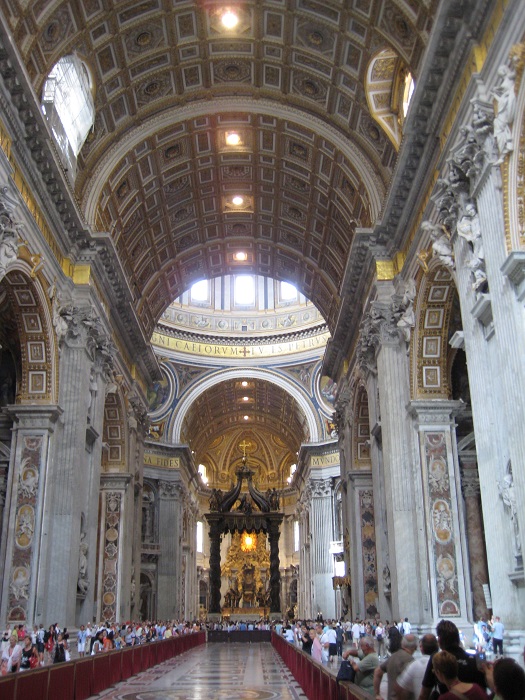
The floor gleams with beautiful inlaid marble patterns. In whatever sort of temple or church I’ve visited around the world, I always dress respectfully, and here a modest dress code is enforced.
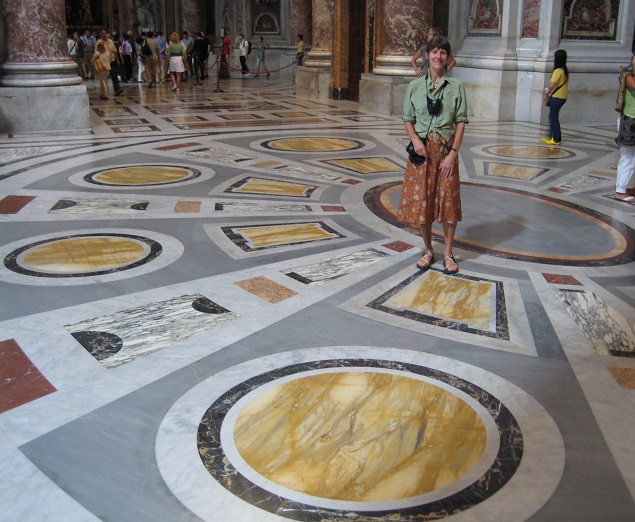
I’m not sure what Thor was trying to capture with the photo below, but it gives a nice closeup of the beautiful stonework and amazing detail of carvings throughout the basilica. The elaborate Baroque decor was very expensive, so the pope(s) approved the selling of indulgences (forgiveness of sins) in order to help finance it. This sort of corruption was part of Luther’s impetus to launch the Protestant Reformation.

We approach the dome soaring 448 feet high above the main altar with its bronze canopy.
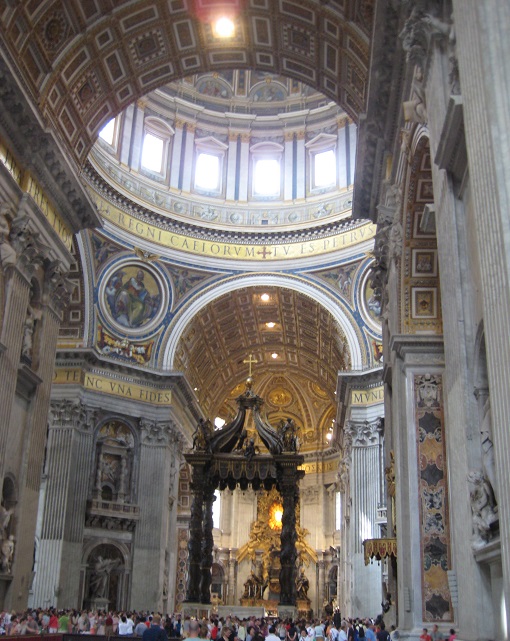
The dome really is sublime.
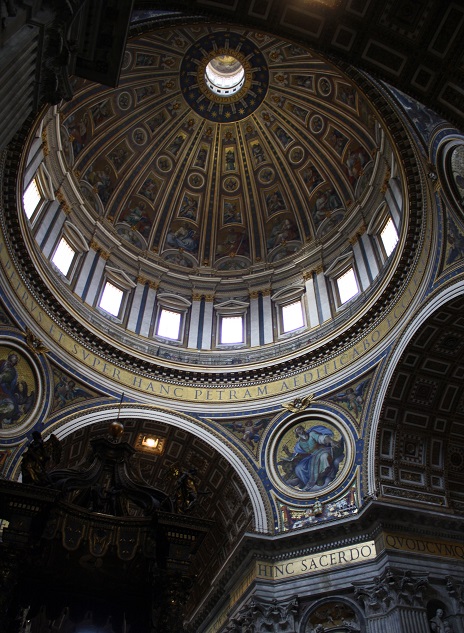
Michelangelo died before the completion of the dome, but succeeding architects finished it to his design. He had studied the ancient Roman Pantheon dome, basing his work on that engineering. The lettering on the golden ring at its base is a Latin quote from the Bible: “You are Peter and upon this rock I will build my church, and to you I will give the keys of the kingdom of Heaven.” (Matthew 16:18) The seven-foot-high letters continue with Biblical quotes around the entire church.

Main Altar and Canopy (Baldacchino):
The altar is a white marble slab with cross and candles, used only by the pope when he says Mass.
Bernini designed the ornate, seven-story bronze canopy over the altar. Its corkscrew columns echo the marble ones that encircled the altar/tomb in the Old St. Peter’s church. (Some of those original columns have been worked into the current basilica.) Some of the bronze for the canopy was scavenged from the Pantheon’s portico ceiling (see my earlier blog post of March 13) and melted down for this structure.
Peter was the first bishop of Rome, who established the authority passed unbroken to around 260 popes after him. Peter – the Rock – is believed to be buried 23 feet below the marble flooring in a crypt. The bones, from an old but healthy man, were studied in 1940 and confirmed to date from the first century when Peter was crucified.
This bronze statue of St. Peter, in the nave, was moved from the earlier church. He holds the keys of heaven, symbol of his authority given by Christ. With the other hand, he blesses the believers. His right big toe has been worn smooth from kisses of the faithful, which are allowed.
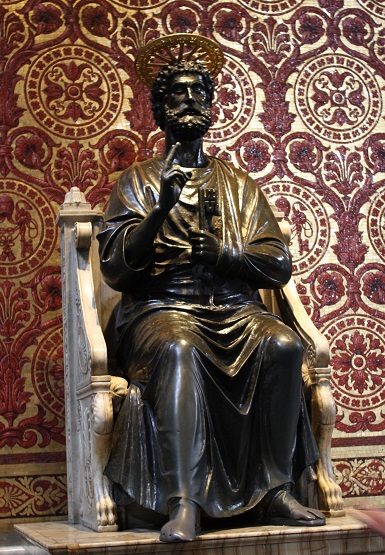
At the far end of the basilica, the Apse (the smaller altar for everyday services) is decorated in the height of Baroque splendor/excess with another Bernini bronze sculpture. (Bernini — 1598-1680 — is sometimes called the Michelangelo of the Baroque era. Michelangelo, earlier, was a Renaissance man.)
The beautiful Dove window of golden alabaster was intended to shine a heavenly light upon the worshippers. In the center (photo is too bright to see it), a 6-foot dove symbolized the Holy Spirit. Golden clouds, angels, and winged babies surround the window. Beneath it Bernini placed the Throne of St. Peter. It was originally an oak chair built in the Medieval era for a king. Bernini bronzed and supported it by four bronze popes symbolizing their authority.
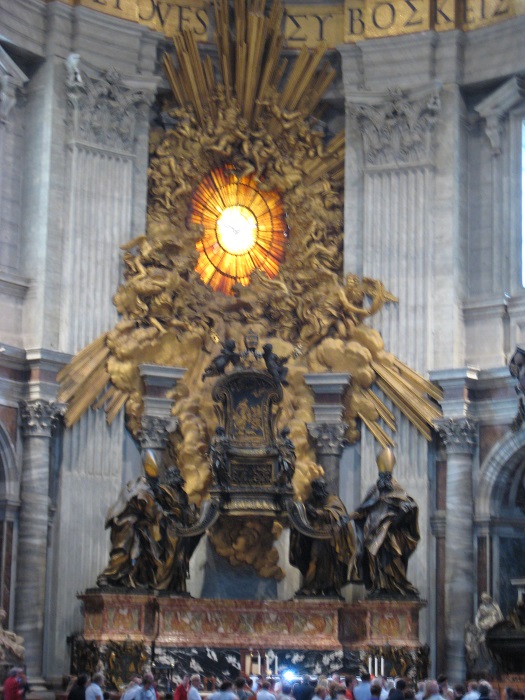
There are several giant “paintings” of religious themes adorning the aisles. All of them are actually mosaics recreating the original paintings. Since 1600 A.D. all paintings inside the basilica were replaced with the mosaics created in the Vatican Mosaic Studio, in order to preserve the originals from smoke and humidity.
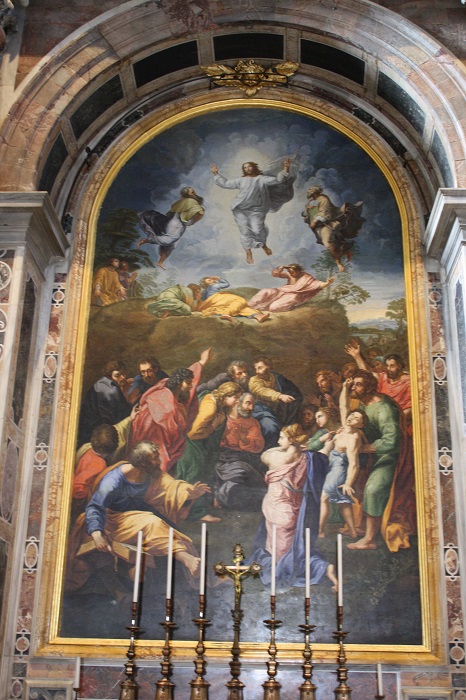
Finally, one of my favorite of all works of art by one of my favorite artists, Michelangelo’s The Pieta (“Pity”). I was thrilled to see it in person. Michelangelo was only 24 when he finished his first important commission, for the Holy Year 1500. It brings the holy down to the human realm, Mary’s face unforgettable in the sadness of holding her dead son after the crucifixion. And the Carrera marble is simply luminous.
It’s said that Michelangelo sculpted with the belief that he was not creating, but only freeing the god-made figure inside the marble, as he was inspired with passion.
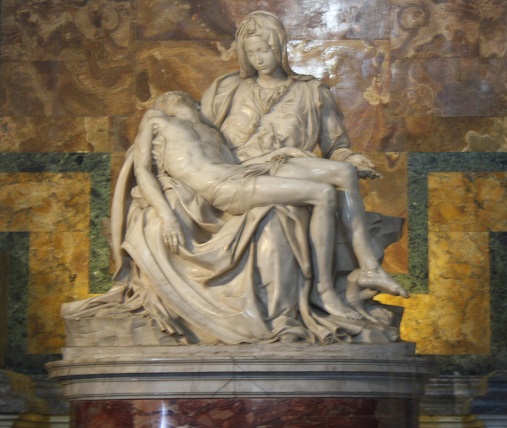
Note: As I started this blog series, I was dismayed to discover that my photos from the trip had gone missing, so I’ve been relying on Thor’s photos. Today I want to thank also our friend and Thor’s paleontology colleague, Patricia Kelley, PhD, for allowing me to show a few of her photos here.
Next week: The Vatican Museum.
*****
You will find The Rambling Writer’s blog posts here every Saturday. Sara’s latest novel from Book View Cafe is available in print and ebook: The Ariadne Connection. It’s a near-future thriller set in the Greek islands. “Technology triggers a deadly new plague. Can a healer find the cure?” The novel has received the Chanticleer Global Thriller Grand Prize and the Cygnus Award for Speculative Fiction. Sara has recently returned from another research trip in Greece and is back at work on the sequel, The Ariadne Disconnect. Sign up for her quarterly email newsletter at www.sarastamey.com

“In all seriousness–without meaning to be frivolous–without meaning to be irreverent, and more than all, without meaning to be blasphemous,–I state as my simple deduction from the things I have seen and the things I have heard, that the Holy Personages rank thus in Rome:
First–“The Mother of God”–otherwise the Virgin Mary.
Second–The Deity.
Third–Peter.
Fourth–Some twelve or fifteen canonized Popes and martyrs.
Fifth–Jesus Christ the Saviour–(but always as an infant in arms.)
I may be wrong in this–my judgment errs often, just as is the case with other men’s–but it is my judgment, be it good or bad.
Just here I will mention something that seems curious to me. There are no “Christ’s Churches” in Rome, and no “Churches of the Holy Ghost,” that I can discover. There are some four hundred churches, but about a fourth of them seem to be named for the Madonna and St. Peter. There are so many named for Mary that they have to be distinguished by all sorts of affixes, if I understand the matter rightly. Then we have churches of St. Louis; St. Augustine; St. Agnes; St. Calixtus; St. Lorenzo in Lucina; St. Lorenzo in Damaso; St. Cecilia; St. Athanasius; St. Philip Neri; St. Catherine, St. Dominico, and a multitude of lesser saints whose names are not familiar in the world–and away down, clear out of the list of the churches, comes a couple of hospitals: one of them is named for the Saviour and the other for the Holy Ghost…!” (Mark Twain)